The Whole Hog
Cooking a Whole Pig on the Grill is Easier Than You Think!
It’s time to go “hog wild” at your next barbecue and cook a whole hog. I know that it sounds like a monumental task that most backyard guys and girls aren’t ready to tackle.
It takes all night to grill a whole hog, right? It’s so big that all the extra meat will go to waste, right?
In fact, it only takes about six hours to grill a 120-pound pig, and that same pig will feed a crowd of about 40 with very few leftovers. Not to mention, it’s super simple. I grill a whole hog at least once a year.
After the pig is on the grill, the rest is so simple that I often go take a nap. The hog is practically maintenance-free once it’s in the cooker.
A few things are required to properly grill a whole hog:
- A whole hog
- A grill measuring at least six feet long by four feet deep – eight feet is ideal
- Three very, very sharp knives
- Two sawhorses
- 100 pounds of charcoal
- Lighter fluid
- Lots of aluminum foil
- Lots of barbecue rub
- An instant-read probe thermometer
- Cheap cloth work gloves
- Latex gloves (I’ll explain these later)
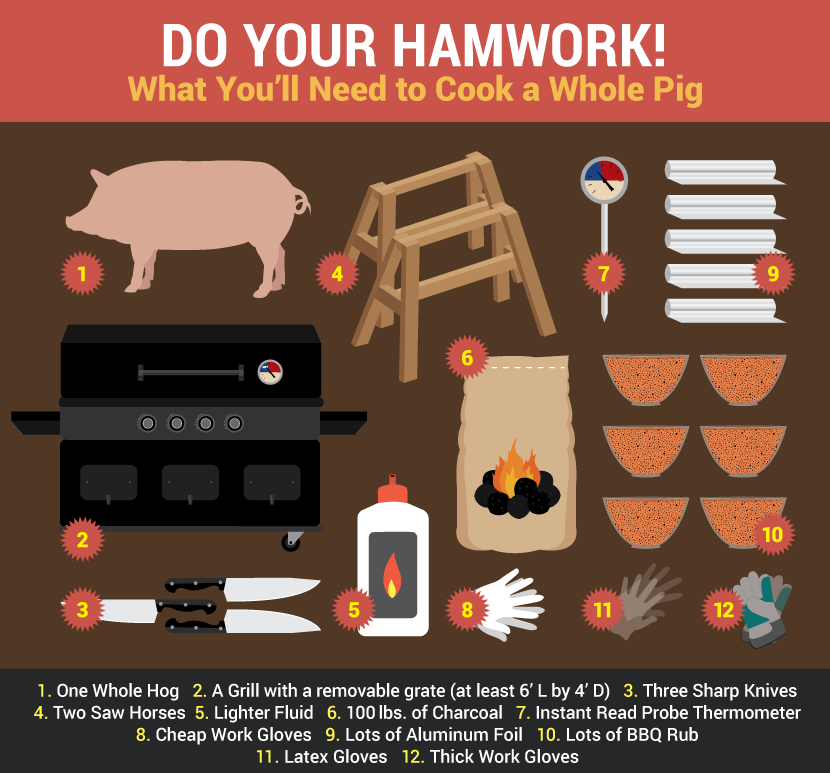
Once the hog and grill are taken care of, the rest is easy. Luckily, both of them can usually be obtained from your butcher. Before I was sponsored by my local butcher, it cost me around $100 to rent a trailered grill big enough to cook a whole hog in.
When ordering the pig, keep in mind that more than half of the weight is the head and bones. Yes, you could probably feed people for less money by cooking many pork shoulders, but it’s not nearly as fun or satisfying.
Trust me – the pig will be a rock star. More selfies will be taken next to your whole-hog grill than you can see in a teenage girl’s Instagram feed.
I generally order a 120-pound pig for 40 to 50 people. I wouldn’t grill anything smaller than an 80-pounder, as it will not be all that tender.
Thick-Skinned Work
Here comes the hard part. Skinning the pig is not all that difficult, but it takes time. And why do we skin the pig?
In the immortal words of Skip Steele, two-time Memphis in May Whole Hog Champion, “Trying to smoke a pig that hasn’t been skinned is like trying to get smoke into a football.”
If it isn’t skinned, it will be bland. Once this part is done, the rest is easy. In fact, once I’ve skinned the pig, I go take a nap.
Item number three on the list above is three very, very sharp knives. I send three of my Japanese steel knives to be professionally sharpened just for the skinning, and by the time I’m done, the first two need to be sharpened again.
The pig can be skinned with a dull knife, but it’s a lot harder.
I’ve done this half a dozen times, and it still takes me about 45 minutes to skin a pig. I’ve seen Skip Steele do it in about 20 minutes. Remember, you’ll be able to reward yourself with a nap soon!
Take the grill grate out of the grill. This requires a couple of people to move a six- or eight-foot steel slab and place it on two sawhorses. This will be the work surface for the skinning.
Place the pig on the grill grate, and make the first cut. Make an incision completely around the neck below the jaw through the tough skin to the soft layer of fat below.
Repeat at the ankles, wrists, and around the anus and tail. Place the pig on its stomach in racer formation (front legs straight out in front and back legs to the rear, as if running), and slice along the edge of the belly on each side of the pig’s body.
Essentially, leave only the skin on the bottom for the pig to rest on. This will help deflect heat. Next, pull the skin back with your free hand and continue to make small slits along the space where the underside of the skin meets the flesh.
Pull the skin slightly with each slice, and the hide will slowly peel back. Keep doing this until the skin comes off in one whole piece.
Slide the pig to one side of the grill grate, and cover the other half with about five layers of aluminum foil. Roll the pig onto the side with the aluminum foil, and cover the other side with foil.
Position the pig on its belly, racer style, at one end of the grate to allow for the cooking of sides and appetizers at the other end. Make sure not to poke any holes in the foil while moving the pig.
Each hole in the foil will act like a blowtorch throughout the cookout.
Finally, season the skinned pig with a heavy layer of salt and the rub (see below for a great rub recipe). Take a breather – the hard part is over.

Create a Rub
Use your preferred rub, or try this one. If you’re making a rub that has lots of sugar in it, I highly suggest using turbinado sugar (otherwise known as raw or unprocessed sugar), which has a much higher blackening point than regular sugar or brown sugar.
You can find it in the baking aisle near the other sugars, and it’s a must-have in the pantry when you’re making barbecue rubs.
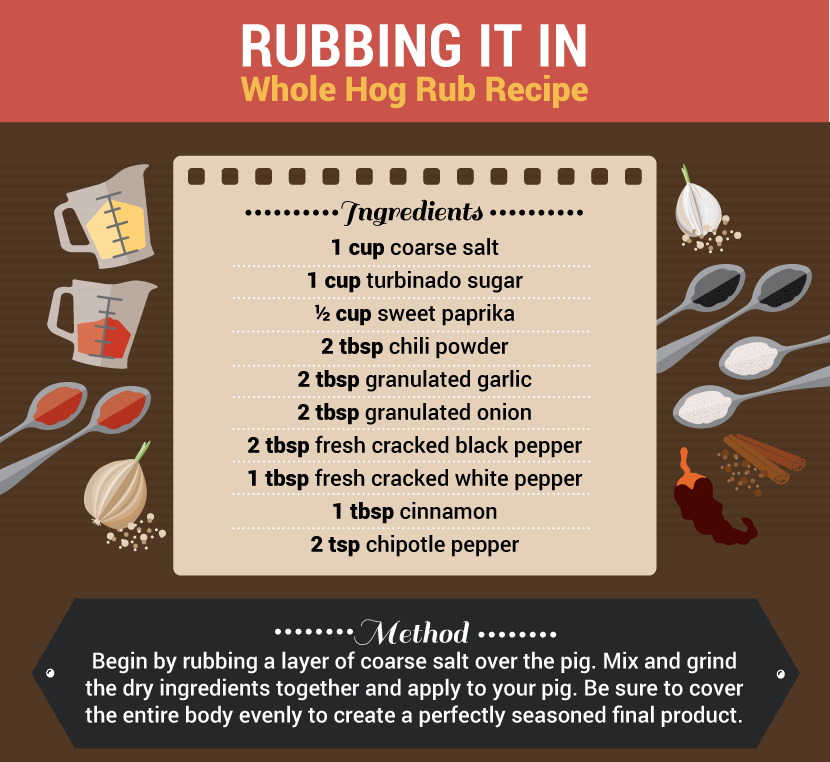
Now it’s time to prepare the grill. Line up the grate next to the spot where it will reside in the grill, and then dump 60 pounds of charcoal under the spot where the shoulders of the pig will be.
Pile up the other 40 pounds under the hams (the rear thighs). Douse each pile with lighter fluid, and light them up. I cringe just writing the words “lighter fluid,” but they don’t make charcoal chimneys that hold 100 pounds of charcoal.
To compensate for that nasty petroleum product just added to the grill, leave the grill open and the pig off to the side for at least 45 minutes so the stink can burn off entirely.
At this point, throw on a few bags of smoke wood chunks, and set the grill grate, pig and all, on the grill and close the lid. Don’t even bother with wood chips, as they will burn up in minutes. Now it’s nap time!
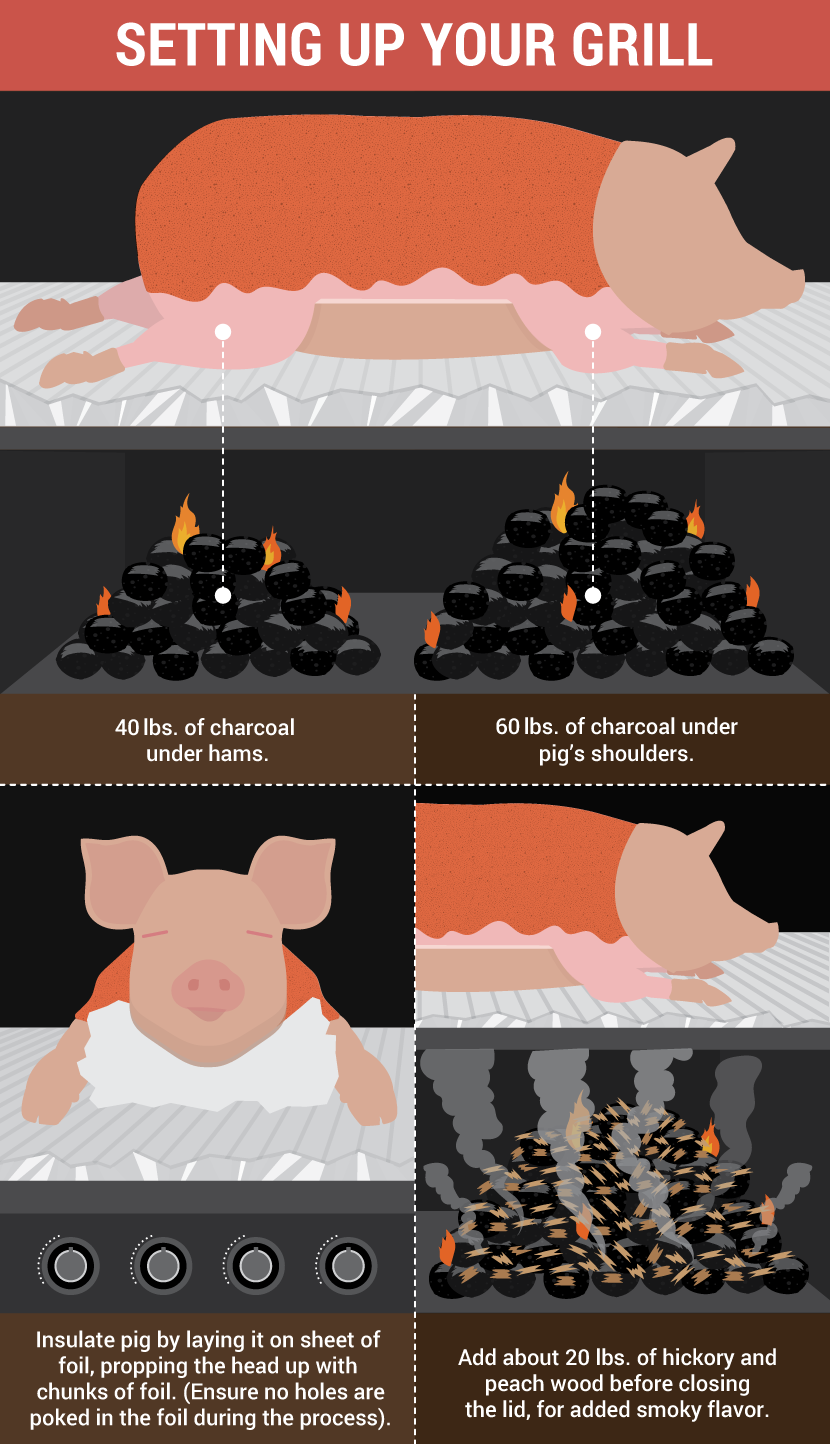
After the Nap
After about three hours, the pig might be getting a little black on the outside. This is not necessarily a bad thing. In the barbecue world, this is called the “bark.”
Good bark is a one-way ticket to Flavortown. If the rub has any kind of sugar in it, the pig could get too black. In fact, the face will turn black pretty quickly because it doesn’t have the fat to counter the heat like the rest of the animal does.
To counter this, cover the body and face in tin foil – an aluminum trench coat and ski mask, if you will. A broomstick handle might help to get the foil pushed down along the back side of the grill.
During the next hour or so is when you should start preparing the sides. I suggest aluminum pans full of baked beans to be smoked alongside the pig.
For a 120-lb pig, I wait about five hours before checking the internal temperature. To do this properly, insert the probe thermometer into the shoulder without touching any of the bones. If the probe touches a bone, it can cause a false reading.
The magic number is 165 degrees at the shoulder. When the shoulder reaches 165 degrees (around six hours for a 120-pound pig), take the grill grate – pig and all – over to the sawhorses to rest for an hour.
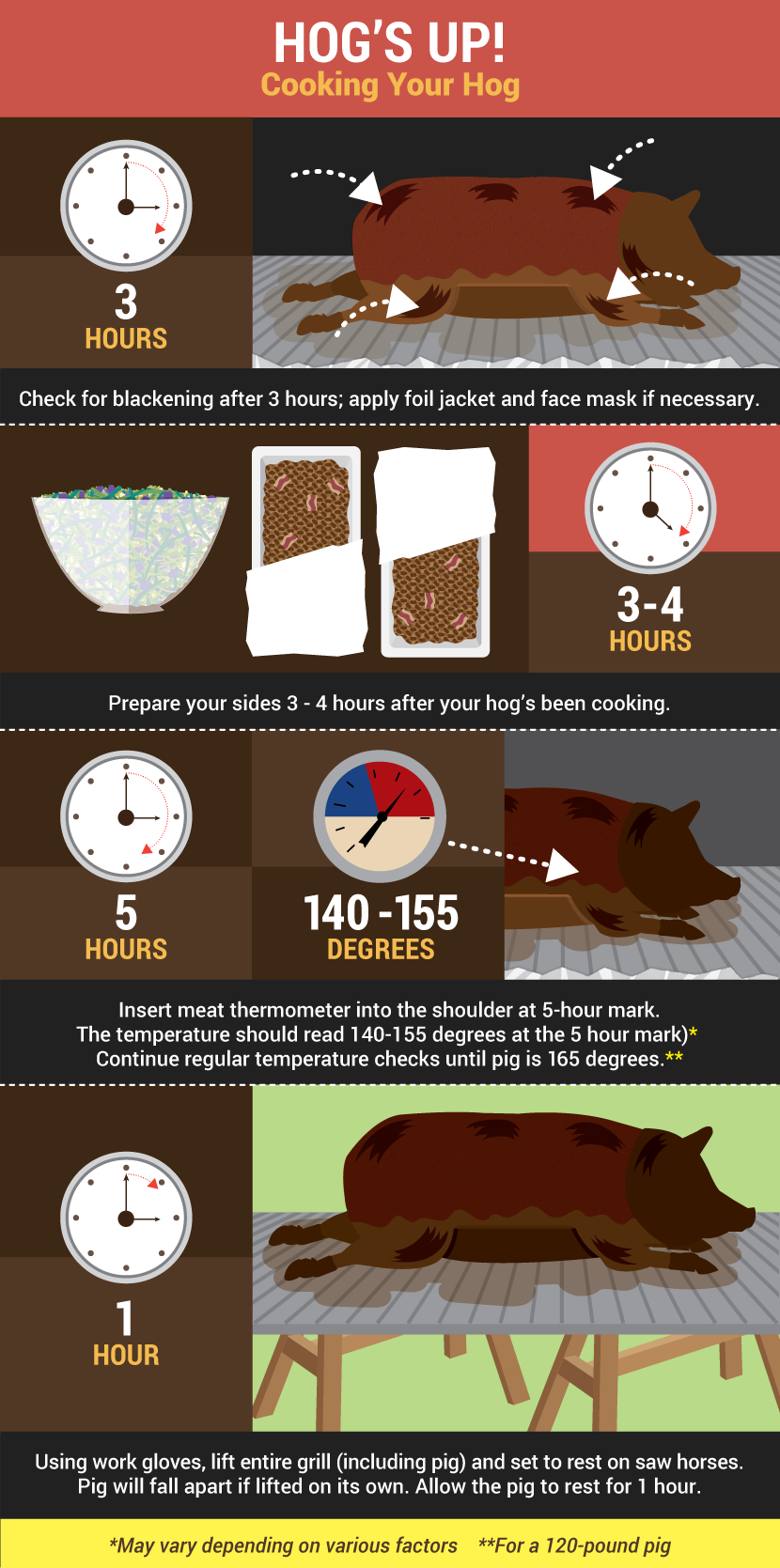
Now don the cloth work gloves to keep your fingers from getting burned, and pull a pair of latex gloves over the first set of gloves to keep the cloth gloves dry.
It’s time to pull the pork. All of the pig’s meat is pulled pork at this point. There won’t be much difference between the meat around the ribs, the belly, and the shoulders.
The rib, spine, and scapula bones should pull out completely clean with only a slight tug. The parts of the pig that will yield the most meat are (in no particular order):
- Shoulders
- Loins and tenderloins
- Hams
- Ribs
- Belly (where the bacon comes from)
- Honorable Mention: the cheeks. (They won’t yield the most meat, but some say that the cheeks are the best part. Feel free to keep that little nugget to yourself and gorge on some cheek.)
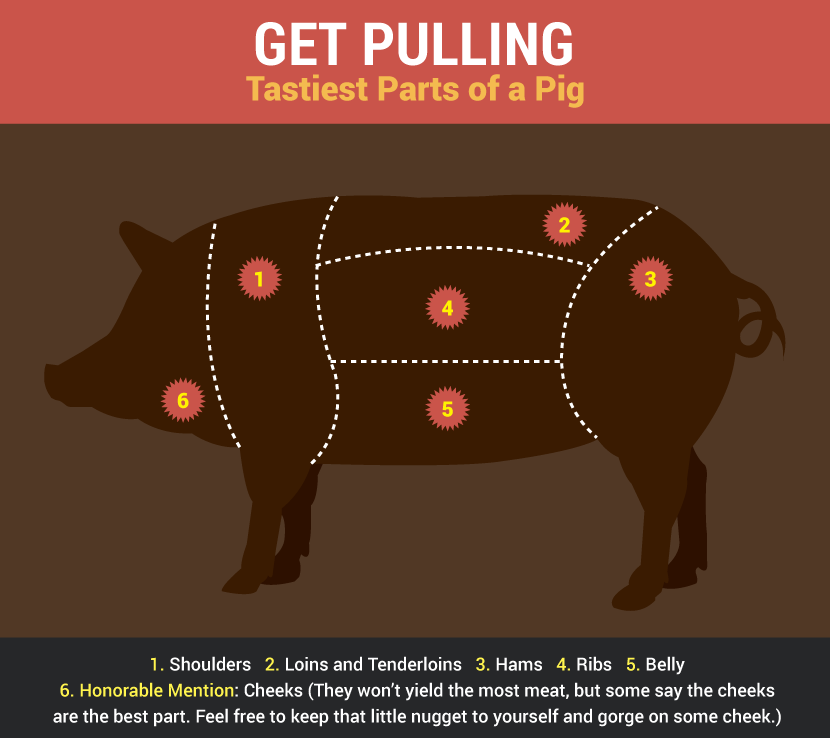
Don’t sweat getting every little sliver of porcine perfection. This is not some frou-frou restaurant with portion sizes in the two-ounce range. Pull it out by the handful and shred it into disposable aluminum pans.
I strongly suggest that this be at least a two-person job. Set the pans of pulled pork on the buffet table alongside barbecue sauce and sides, and enjoy.
Embed the article on your site

